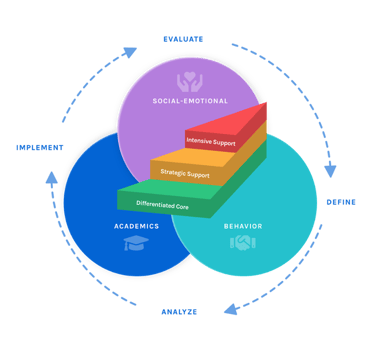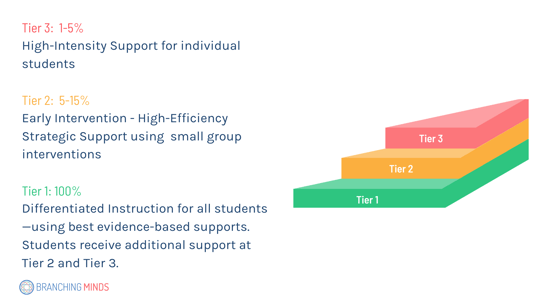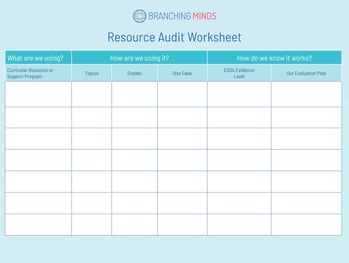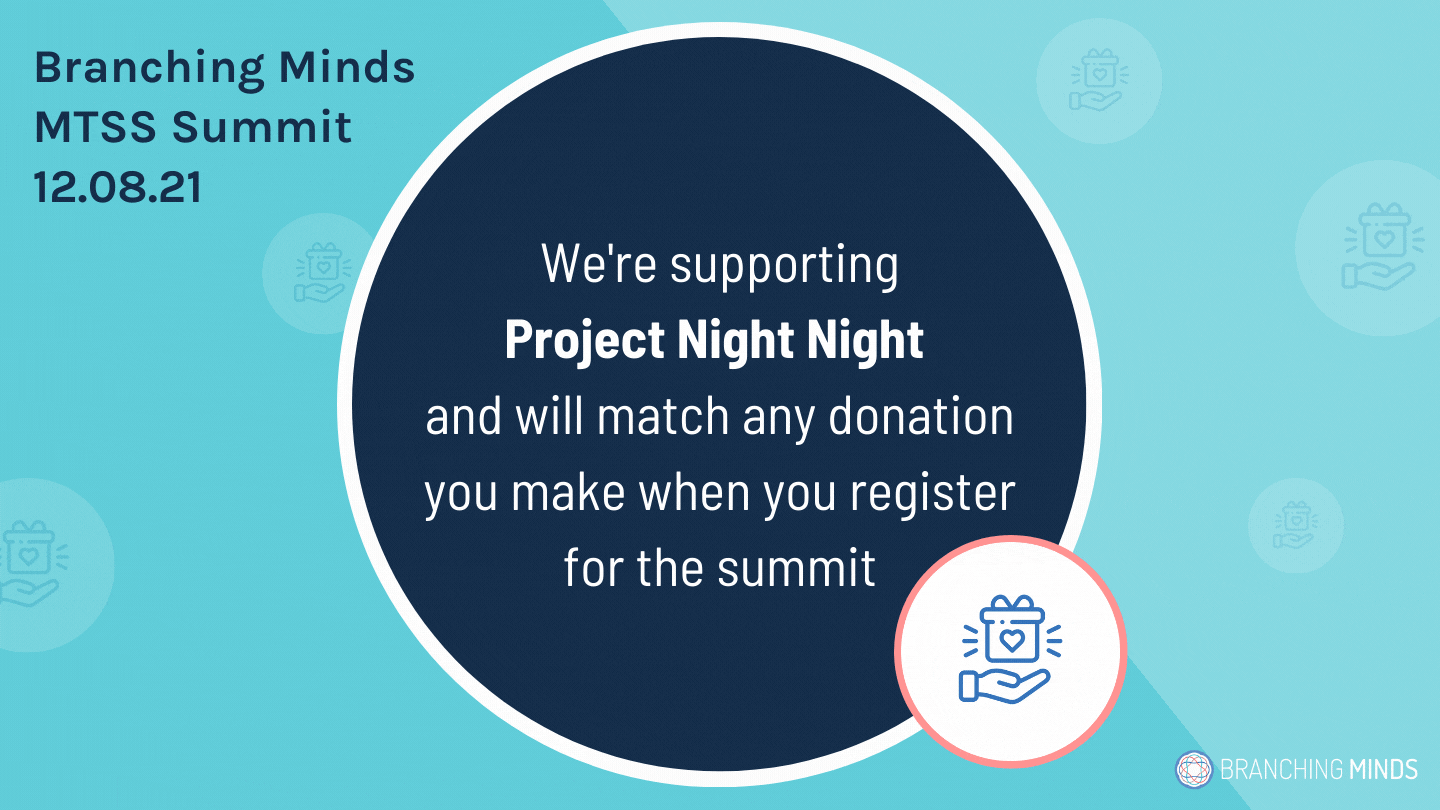
Aligning SMART Goals to the Just-Right MTSS Interventions

A Multi-Tiered System of Supports (MTSS) framework uses a problem-solving cycle to monitor and adjust instruction and intervention at three tiers:
- Tier 1: whole class data-driven differentiated core instruction,
- Tier 2: whole-class differentiated instruction + small group targeted instruction (in addition to core instruction), and
- Tier 3: whole class core differentiated instruction + additional targeted instruction (often small group in addition to core instruction) + intensive support.
An optimal MTSS framework follows the 80-15-5 model, suggesting that our core instruction should meet 80% of our learners' needs. With strong core instruction, 80% of students will not require additional intervention. However, core instruction should be targeted to support all students through the use of differentiation and research-based learning supports. This means Tier 1 targets 100% of students, not just 80% of our students.
However, we can't negate that even with the most effective, evidence-based, validated core instruction, some learners will continue to need targeted and intensive interventions and support plans for some of their needs. When this happens, it's important we identify the student's goal, select an appropriate intervention, develop a support plan, and set frequency and type of monitoring for progress.

One of the most common questions I’ve received over the years has been, "How do I know the intervention I selected will help my student meet the goal?" How do I select the proper intervention once I've set the SMART goal for my student? In other words, you've identified the difference between what was expected of the student (skill) and what is happening, but now what?
The Fuchs Research Group of Peabody College at Vanderbilt University has created hundreds of peer-reviewed articles that help teachers select the best interventions for students. With all that's on your to-do list these days, I wanted to share the top five guidelines from Fuchs' research that will help you align your SMART goals and interventions to optimize student success. A little tip, the more guidelines the intervention meets, the more likely it will maximize student success.
1. Check the "Strength" of the Intervention
Start with a standard, evidence-based practice/program with documented evidence of effectiveness informed by research and evaluation. These intervention practices/programs have research indicating when adequately aligned to students' needs, and they tend to work and require modest amounts of training to implement.
Now, it's important to remember that not every evidence-based strategy has the same efficacy or strength. So be sure to select an intervention that has a moderate effect size or greater when implemented with fidelity, or precisely as the intervention tool recommends—user-friendly websites, like What Works Clearinghouse, indicate the effect size of evidence-based practices/programs.
ASK YOURSELF: What is the evidence rating for the intervention?
Not all educational strategies were created equally. Many databases, such as the What Works Clearinghouse, curate interventions under the guidelines of ESSA. ESSA (the Every Student Succeeds Act) was developed to help educators select interventions that are grounded in research. These databases take the guesswork out of identifying quality interventions by evaluating the trustworthiness and validity of the research behind the interventions.
Evidence ratings are based on how well the experiments implementing the interventions with students were conducted and how strongly the evidence suggests a correlation between the instructional strategy or tool and the student outcome. It’s essential to review the evidence rating as well as how the database quantifies their ratings. Some use strong, moderate, and promising as an example. The higher the rating, the more likely the intervention will produce results for students when implemented with the researched fidelity.
2. Determine the "Dosage"
"Dosage" refers to the opportunities a student has to respond and receive feedback during an intervention or how many opportunities and for what period the student engages with the intervention. Most evidence-based intervention programs will provide you with information on how many options the student has to respond to during an intervention session, including the length of the lesson, activities, and number of recommended students in the group when following the standardized, evidence-based intervention program as designed.
If this information is not available, take a test drive through a practice lesson to get a sense of how often the student responds to prompts AND receives feedback. Remember that at first, you always want to implement the intervention as the research indicates it should be implemented.
ASK YOURSELF: Does the intervention offer the student enough practice?
Practice includes student engagement in learning activities with simultaneous corrective feedback. Research indicates that students who are struggling to make progress need ten to thirty times more opportunities than their peers to apply a skill or strategy (Fuchs 2014)! This is an easily adaptable component of an intervention. The dosage can be changed by adding more sessions, more minutes, or splitting longer sessions depending on the students' needs.
➡️ Related Resource: A Quick Review of MTSS Supports, Interventions, and Accommodations
3. Best Formula for Alignment:
Assessment Outcomes + Grade Level Standards = Smart Goal/Intervention Alignment
How did you determine the SMART goal that your student is working on mastering? A deep dive into a student's formative assessments and summative assessments, including screener data, will help you identify the target skills needing improvement.
The SMART goal you set for your student should be directly linked to the target skills. That's how we use our handy equation; what did I learn about my student's skill needs from their assessment + what they need to be achieving according to the standards = creating a SMART goal that drives a learning intervention.
The research behind evidence-based practices indicates that the intervention will show improved learning outcomes. How well does the intervention select match the skill needs of the student? Ensure that the intervention doesn't spend time addressing skills that the student has already mastered. Check that the intervention focuses on grade-level appropriate standards to accelerate learning and close the skill gap.
ASK YOURSELF: Does the intervention I selected follow the Alignment Formula: Assessment Outcomes + Grade-Level Standards = Smart Goal/Intervention Alignment?
A chosen intervention that meets the student's skill deficit should help them close the gap to meet their grade-level appropriate skills and standards. If you notice a student who isn't responding to an evidence-based strategy, you may want to ask if you have identified the right goal or struggle skill.
Problem or goal identification can be tricky when thinking back to our MTSS problem-solving cycle. It’s important to use screener and benchmark data, additional assessments, and inventories to identify what the student can do and what skill the student needs additional opportunities to learn with a grade-level appropriate focus.
➡️ Audit your intervention process with this free worksheet
4. Built-in Opportunities to Transfer or Generalize New Skills
Preparing to help your student make connections between their learning and applying the skills in different environments is essential to interventions. Check the intervention practice/program for activities that include self-regulation strategies that students can adapt to any environment. These strategies may include goal setting, organizing, mnemonic devices, checklists, varying opportunities to practice, cumulative reviews that have skills previously taught. Check out 6 Research-Based Interventions for Writing.
ASK YOURSELF: Will this help the student develop strategies and skills they can use independently without support across different environments?
In order for students to make connections between their learning and environments, or to transfer skills, students must take responsibility for their own learning. Interventions that we select must have opportunities for the student to practice after observing you as the expert.
Guided practice and opportunities for independent practice that you can monitor will let you know if the student can apply their learning in other environments. Interventions that include opportunities for modeling, guided, and independent practice lend themselves to building capacity within the student to transfer newly learned skills.
5. Is the Instruction Explicit?
Explicit instruction is a way of teaching where the teacher provides overt instruction on the skill and allows the student to practice with scaffolds until they achieve mastery systematically. Check to ensure the intervention offers simple, direct language, models strategies, especially self-regulating strategies like the list above, gradually fades support as students gain confidence, and includes a cumulative review.
ASK YOURSELF: How often am I interacting with the content and the learner?
Explicit instruction provides many opportunities to model and engages the student in guided and independent practice. During an intervention, we support the learner by giving clear directions and expectations, using clear and direct language and vocabulary, and monitoring the student's progress, positively providing immediate, specific corrective feedback. Explicit instruction during the intervention will help you tweak the intervention just-in-time to fade or increase support for the student.
➡️ Related Resource: Intervention Planning in MTSS: How to Balance Best Practices and Feasibility
Last Notes
Remember, there are no perfect interventions. However, there are ways for us to select interventions that most closely align with our students' individual and targeted group goals and needs and have been demonstrated through research to be effective. These guidelines help eliminate non-aligned interventions and more appropriately select the intervention that will best support students with a particular need or goal. Check out our webinar on successful intervention planning in MTSS.
Citations
Fuchs, D., Fuchs, L., & Vaughn, S. (2014). What is intensive instruction, and why is it important?
The CEEDAR Center. Retrieved November 1, 2021, from https://ceedar.education.ufl.edu/wp-content/uploads/2016/11/Fuchs-D.-Fuchs-L.S.-Vaughn-S.-2014.-What-is-intensive-instruction-and-why-is-it-important_-Teaching-Exceptional-Children-46-13-18..pdf.
Fuchs, L. S., Fuchs, D., & Malone A. S. (2017). The taxonomy of intervention intensity. Teaching Exceptional Children, 50(1), 35–43.
Additional Resources
Designing Intensive Intervention for Students with Severe and Persistent Academic Needs (DBI Training Series, Module 7)
So, What Do I Do Now? Strategies for Intensifying Intervention When Standard Approaches Don't Work (webinar) Introduction to Data-Based Individualization: Considerations for Implementation in Academics and Behavior (DBI Training Series, Module 1)
Give back with us this season at the
Branching Minds MTSS Summit
Check out Project Night Night's mission here
The most comprehensive and instructive library of evidence-based learning supports of any MTSS platformBranching Minds has the most comprehensive and instructive library of evidence-based learning supports of any MTSS platform. Our supports include hundreds of paid evidence-based intervention programs, as well as nearly a thousand free evidence-based strategies, activities, and resources. For each of these supports, BRM helps educators understand what the support is, why and for whom it should be used, how it should be delivered, and connects them to the supporting research and additional material. Our learning science team has curated these resources from the most trusted and respected hubs of evidence-based supports, including the Florida Center for Reading Research, What Works Clearinghouse, Evidence for ESSA, Intervention Central, the IRIS Center from Vanderbilt University, Harmony SEL; and, each one has been reviewed and categorized based on the ESSA tiers of evidence guidelines. Want to learn more?
|
![[Guest Author] Brittany Shurley](https://fs.hubspotusercontent00.net/hubfs/5825404/image0.jpeg)
[Guest Author] Brittany Shurley
Brittany Shurley has served students, educators, and leaders in various roles throughout her career including as a classroom teacher, learning disabilities specialist, school-based leader, and district level administrator. Brittany has extensive experience in facilitating the implementation of an MTSS at the district and school levels. She is passionate about ensuring teachers have the tools to promote safe, healthy, and engaging learning environments where students are experiencing success.
Related Posts
Tagged: Tier 2, Tier 3, Interventions and Learning Supports' Strategies








Comments (1)